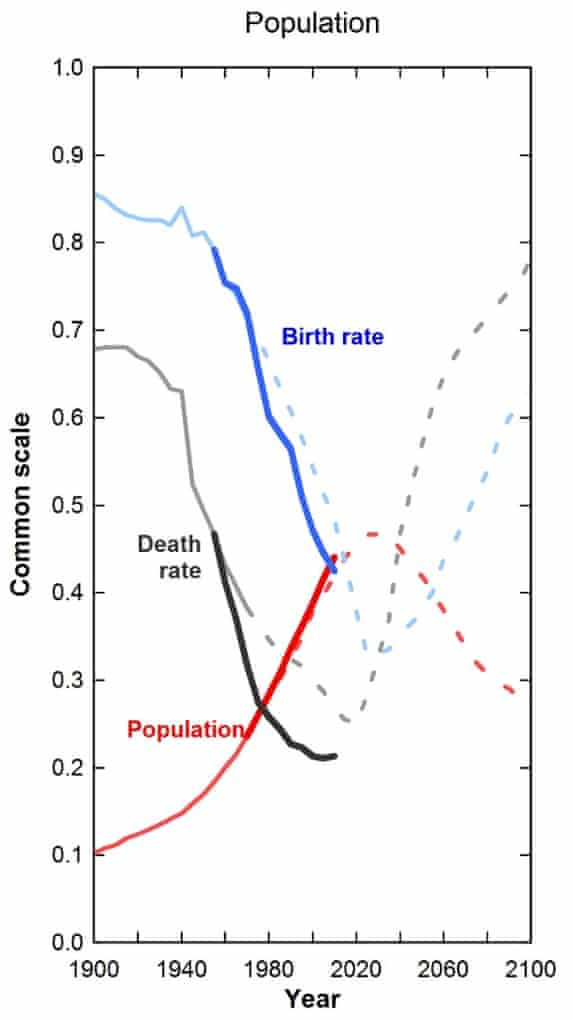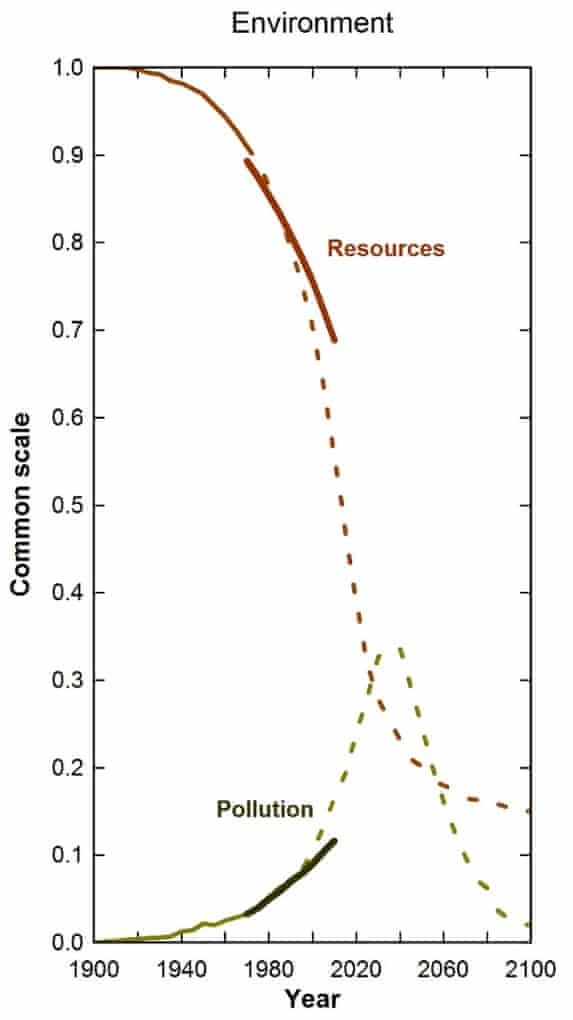Review the Two Traditions for Environment Technology Vs Limits to Growth
T he 1972 book Limits to Growth, which predicted our civilisation would probably plummet some time this century, has been criticised as doomsday fantasy since information technology was published. Dorsum in 2002, cocky-styled environmental skilful Bjorn Lomborg consigned information technology to the "dustbin of history".
It doesn't vest there. Enquiry from the University of Melbourne has institute the book'due south forecasts are accurate, 40 years on. If we continue to runway in line with the volume's scenario, wait the early on stages of global collapse to commencement actualization soon.
Limits to Growth was commissioned past a think tank called the Club of Rome. Researchers working out of the Massachusetts Institute of Engineering science, including married man-and-wife squad Donella and Dennis Meadows, built a computer model to track the world'southward economic system and environment. Chosen World3, this figurer model was cut edge.
The task was very ambitious. The team tracked industrialisation, population, food, utilise of resources, and pollution. They modelled data upwardly to 1970, and so developed a range of scenarios out to 2100, depending on whether humanity took serious action on environmental and resource bug. If that didn't happen, the model predicted "overshoot and plummet" – in the economy, environment and population – before 2070. This was called the "business-as-usual" scenario.
The book'southward key signal, much criticised since, is that "the globe is finite" and the quest for unlimited growth in population, material goods etc would eventually lead to a crash.
And so were they correct? We decided to check in with those scenarios after forty years. Dr Graham Turner gathered data from the UN (its department of economical and social affairs, Unesco, the food and agronomics arrangement, and the UN statistics yearbook). He also checked in with the The states national oceanic and atmospheric administration, the BP statistical review, and elsewhere. That data was plotted alongside the Limits to Growth scenarios.
The results bear witness that the globe is tracking pretty closely to the Limits to Growth "business-equally-usual" scenario. The information doesn't match up with other scenarios.
These graphs show real-globe data (start from the MIT work, then from our research), plotted in a solid line. The dotted line shows the Limits to Growth "business-equally-usual" scenario out to 2100. Up to 2010, the data is strikingly similar to the book'due south forecasts.



Every bit the MIT researchers explained in 1972, under the scenario, growing population and demands for textile wealth would lead to more than industrial output and pollution. The graphs evidence this is indeed happening. Resources are existence used up at a rapid rate, pollution is rising, industrial output and food per capita is ascent. The population is rising quickly.
So far, Limits to Growth checks out with reality. So what happens next?
Co-ordinate to the book, to feed the continued growth in industrial output at that place must be always-increasing use of resources. But resources become more expensive to obtain as they are used up. Equally more and more than capital goes towards resources extraction, industrial output per capita starts to fall – in the book, from about 2015.
Every bit pollution mounts and industrial input into agriculture falls, nutrient production per capita falls. Health and instruction services are cut back, and that combines to bring about a rise in the death charge per unit from nearly 2020. Global population begins to fall from nigh 2030, by well-nigh half a billion people per decade. Living conditions fall to levels similar to the early 1900s.
It'due south essentially resource constraints that bring well-nigh global collapse in the book. Withal, Limits to Growth does factor in the fallout from increasing pollution, including climate change. The book warned carbon dioxide emissions would have a "climatological effect" via "warming the temper".
Equally the graphs show, the University of Melbourne research has not institute proof of collapse every bit of 2010 (although growth has already stalled in some areas). Only in Limits to Growth those effects only start to seize with teeth around 2015-2030.
The showtime stages of decline may already have started. The Global Financial Crisis of 2007-08 and ongoing economic angst may be a harbinger of the fallout from resource constraints. The pursuit of material wealth contributed to unsustainable levels of debt, with of a sudden higher prices for food and oil contributing to defaults - and the GFC.
The issue of peak oil is disquisitional. Many independent researchers conclude that "easy" conventional oil production has already peaked. Even the conservative International Energy Agency has warned about peak oil.
Height oil could be the goad for global collapse. Some encounter new fossil fuel sources like shale oil, tar sands and coal seam gas as saviours, only the result is how fast these resources can be extracted, for how long, and at what price. If they soak up too much uppercase to extract the fallout would be widespread.
Our research does not point that collapse of the earth economy, environment and population is a certainty. Nor practice we merits the time to come volition unfold exactly as the MIT researchers predicted dorsum in 1972. Wars could break out; so could genuine global ecology leadership. Either could dramatically touch the trajectory.
Just our findings should sound an alarm bell. Information technology seems unlikely that the quest for ever-increasing growth can continue unchecked to 2100 without causing serious negative effects – and those effects might come sooner than we remember.
Information technology may be also late to convince the world'due south politicians and wealthy elites to chart a dissimilar course. So to the remainder of us, maybe it's time to think near how we protect ourselves as nosotros head into an uncertain future.
As Limits to Growth concluded in 1972:
If the present growth trends in world population, industrialisation, pollution, food production, and resource depletion go on unchanged, the limits to growth on this planet will be reached sometime inside the side by side one hundred years. The near probable result will be a rather sudden and uncontrollable decline in both population and industrial capacity.
So far, at that place'south little to betoken they got that wrong.
Source: https://www.theguardian.com/commentisfree/2014/sep/02/limits-to-growth-was-right-new-research-shows-were-nearing-collapse
0 Response to "Review the Two Traditions for Environment Technology Vs Limits to Growth"
Post a Comment